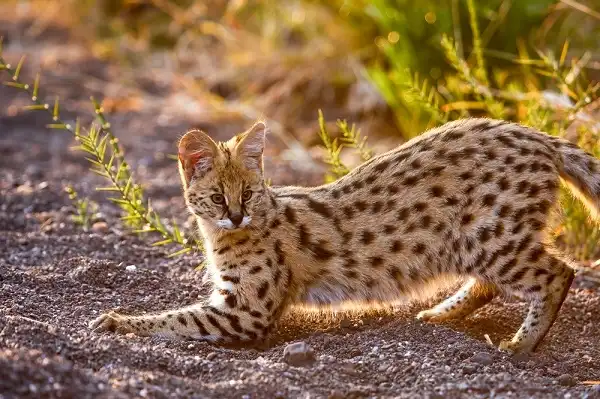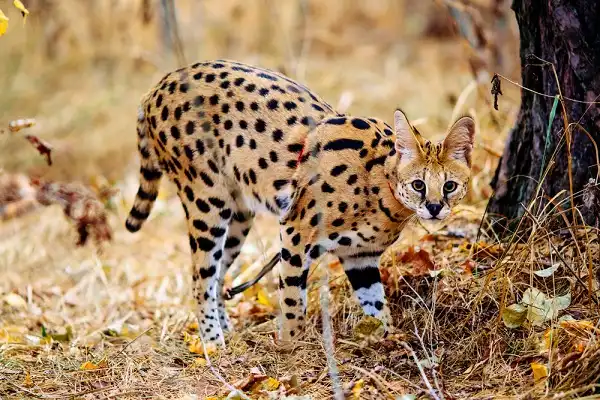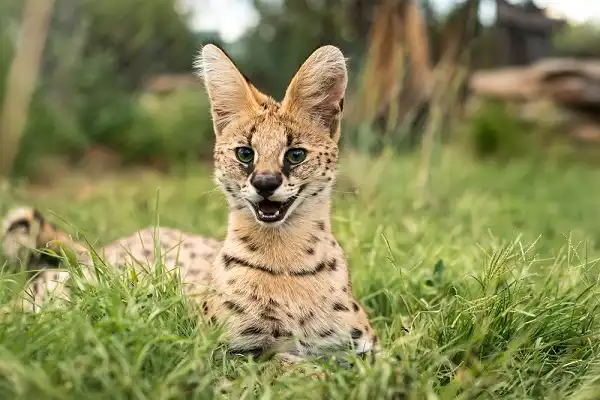Have you ever heard of the fascinating creature known as the Serval? This medium-sized, wild cat–native to Africa–is renowned for its stunning beauty and impressive hunting skills. Not only is this creature incredibly glamorous to behold; but it has also been providing inspiration for centuries with stories, legends, artworks, sculptures, and even fables created in its homage! With a strong focus on conservation today thanks to such efforts as National Geographic’s Big Cats Initiative, let’s take some time together to explore the history of this majestic animal and understand why it is so deeply revered across cultures.

Serval Description
The Serval is an iconic African wild cat that stands out for its eye-catching beauty and impressive hunting abilities. With a slender, muscular body and long legs, the Serval has a tawny yellow fur coat with black rosettes and stripes, making it easily recognizable. The serval’s ears are very long and pointed, and its head is adorned with tufts of fur resembling facial hair. In recent years conservationists have been working hard to protect this majestic animal from extinction through initiatives like National Geographic’s Big Cats Initiative. Despite their captivating beauty, servals still face threats such as habitat loss due to human development and illegal poaching for their fur. It’s up to us now to ensure our future generations will be able to appreciate this incredible creature just like we do today!
Serval Habitat
The Serval is an African wild cat that can be found in a variety of habitats, primarily savannas and grasslands. They prefer areas with plenty of vegetation, as this allows them to find shelter and hunt for prey. These cats are also known to live in more densely forested areas, but they tend to avoid areas where there is a high human population or large predators such as lions or leopards. The Serval’s habitat has been rapidly changing over the past few years due to human development. As people continue to encroach on natural areas, servals are losing vital hunting grounds and safe havens from larger predators. Conservationists are now actively working towards protecting this species before it’s too late through initiatives like National Geographic’s Big Cats Initiative.
Serval Diet
The Serval is a wild cat that has an impressive and varied diet. Primarily, they feed on small animals like rodents, frogs, hares, lizards, and amphibians – which they locate through their acute hearing. They are also known to catch birds in flight by jumping up to 10 feet into the air! Moreover, the Serval is an opportunistic omnivore; meaning that they will take advantage of whatever food sources are available in their environment. This could include fruits, berries, eggs, or even carrion (dead animals). They also consume grasses and other vegetation to supplement their diet with the necessary nutrients. Overall, Serval’s diet allows them to maintain a healthy lifestyle in the wild since it gives them access to important vitamins and minerals that keep them strong and energized. Furthermore, their hunting skills help provide enough food for themselves as well as for any cubs they may have.

Serval Size
The Serval is a medium-sized African wild cat that can reach sizes between 20-30 pounds. Males are usually larger than females, and their slim yet muscular body is adorned with tawny yellow fur coat featuring striking black rosettes and stripes. With their long, pointed ears and tufts of facial hair, the Serval is an undeniably beautiful animal. Their impressive size allows them to hunt down larger prey like small birds, lizards, and amphibians with ease. Unfortunately, the serval’s size has made them vulnerable to threats such as illegal poaching and habitat loss due to human development.
Serval Lifespan
The Serval is an African wild cat that has a typical lifespan of 12-14 years in the wild. In captivity, they can live up to 18 years or longer due to better access to food and lack of predators. Servals exhibit early maturity; males reach sexual maturity by the age of 11 months and females can start reproducing at 18 months old. They have a reproductive season that lasts from June to August, during which females enter estrus (heat) for roughly two weeks every month. The average litter size is two or three cubs, with gestation lasting approximately 75 days. In terms of longevity, servals are generally considered healthy animals that enjoy relatively long lifespans given their environment and diet. However, their life expectancy can be affected by human activities such as habitat destruction and poaching, which create more obstacles for them when trying to survive in the wild.
Serval Behavior
The Serval is an active nocturnal animal, mostly seen hunting or patrolling its territory during the night. This helps them to avoid daytime predators such as lions or leopards and also increases their chances of finding prey. They are solitary animals that live alone, but will occasionally come together with larger groups for mating purposes. Servals are known to be very vocal cats; they communicate with each other through loud meowing sounds and hisses. During the day they rest in sheltered areas such as hollow tree trunks, rock dens, or dense vegetation. When threatened, servals may use defensive tactics like arching their back and raising their hackles to appear larger and more intimidating; this usually works well enough to ward off most predators. Overall, Servals have adapted extremely well to life in the wild thanks to their incredible senses and physical capabilities.

Serval Speed
The Serval is an incredibly agile cat that can reach impressive speeds up to 50 mph (80 km/h) while running and 40 mph (64 km/h) when bounding. This speed is unmatched by any other African wildcat, allowing them to catch their prey with ease even when it’s hidden underground or in dense vegetation. The serval’s speed also makes it a formidable hunter in the wild since it can quickly run down rabbits, lizards, frogs, and other small animals as well as larger birds. Their acute hearing also helps them locate prey that may be hidden underground or in dense vegetation. Although servals are primarily carnivorous animals, they will also take advantage of whatever food sources are available including fruits and berries as well as carrion (dead animals).
Serval Reproduction
Serval reproduction is a fascinating process that begins with courtship. During this courtship period, the male serval will engage in ritualized behaviors to attract the female’s attention and solicit her interest. This can include scent marking, vocalizations, and physical displays such as posturing and body rubbing. If successful, the female will usually respond by giving out a single “chirp” sound which indicates her acceptance of his advances. Upon mating, servals typically have a gestation period of around 2-3 months before they give birth to their litter of 1-4 kittens. The newborns are born blind and helpless, weighing only 4 ounces (115 grams) and measuring about 8 inches (20 cm) in length.
At first, the mother cat will leave her kittens hidden away in some form of secluded den while she goes out hunting for food; she will return several times during the day to feed them until they are old enough to follow her out on hunting trips when they reach 2 months of age. It is during this time that she will teach them how to hunt and survive on their own in the wild. Servals reach sexual maturity at around 10-12 months of age but will usually not breed until their second year due to the amount of energy it requires for successful breeding and rearing of offspring. However, once ready they can produce 2 litters per year!
Serval Hunting
Serval hunting is among the most impressive hunting strategies used by this majestic African wild cat. Thanks to their remarkable speed and agility, servals are formidable hunters in the wild. They can quickly run down rabbits, lizards, frogs, and other small animals as well as larger birds. Furthermore, they have an acute sense of hearing which helps them locate prey that may be hidden underground or in dense vegetation. When hunting for prey, servals typically use a combination of stealthy stalking movements with quick bursts of acceleration for short distances in order to corner their meal before pouncing on it with deadly accuracy.

Conclusion
The serval is an extraordinary creature that has adapted to its environment in order to survive. Its physical abilities coupled with its acute sense of hearing and ability to blend into the surroundings make it a formidable hunter in the wild. Unfortunately, human activities such as illegal poaching and habitat destruction have threatened this species survival.
Frequently Asked Question

